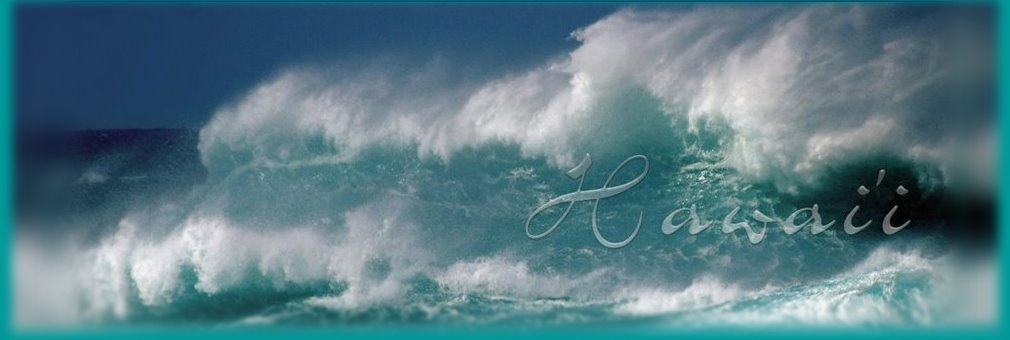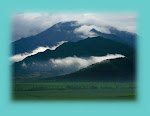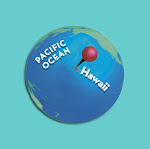For Surfers, All Waves Lead to Hawaii
Catching a wave of almost 20 feet at Waimea Bay on Oahu's North Shore
SPENDING time on the North Shore of Oahu, just 30 miles from the urban sprawl of Honolulu, provides a crash course in the hang-10 lifestyle. Old surfboards serve as signposts for the driveways of wooden bungalows, the fronts of shops and the turnoff points for restaurants at this fabled surf Mecca. Even the barbecue delivery car has a surfboard strapped sideways on its roof as a makeshift billboard.
There is hardly a waiter, store clerk or bartender around who doesn't have a ripped physique, a sun-burned nose and flip-flops barely encasing scraped-up feet - all signs of the hard-core surfer. Out in the lineup, in the calm water just outside the break where throngs of surfers jockey to catch waves, it is not uncommon to see Hawaiian grandmothers longboarding among teenagers covered in tribal tattoos doing aerial maneuvers.
Pro surfers, especially those who grew up on the North Shore, rule the hierarchy. Local surf stars like Fred Patacchia, Pancho Sullivan, Jamie O'Brien and Megan Abubo, who was the stunt double for Michelle Rodriguez's character in the film "Blue Crush," can be spotted hauling groceries to their trucks at the parking lot at Foodland or at Haleiwa Joe's, the North Shore equivalent of the Ivy in Beverly Hills, where pros and potential sponsors dine, and contest victory celebrations are held. On a recent morning at Cafe Haleiwa, decorated like all restaurants here with old surf photos and paintings of giant barreling waves, Ms. Abubo, tanned and muscular, was fielding calls from producers for television programs and commercials looking for stunt doubles and pro surf specimens.
"The North Shore is a little like going back in time," Ms. Abubo said. "Even though the crowds have tripled in the last few years, people still hitchhike to get around, and there's a tightknit community. It's the best place in the world for a surfer to live."
The North Shore is now in a rather sticky situation of courting fame while trying to preserve an old-school, precrowd vibe. The throngs began to show up, boards under arms, soon after the release of "Blue Crush" four years ago. The Drew Barrymore-Adam Sandler film "50 First Dates," episodes of "Baywatch" and the WB reality series "Boarding House: North Shore" were all recently filmed here.
And the primetime hit "Lost" - its base camp in the tropical vegetation between Haleiwa, the historic town founded by missionaries in the 1800's on the southwest end of the North Shore, and Waimea Bay - has set scenes on dozens of the coconut-strewn sandy beaches and thick jungles here. (An amusing pastime for fans is to ferret out locations like the site of a plane crash scene, which was shot just to the left of a Y.M.C.A. camp on Farrington Highway.)
Yet, its Hollywood connections aside, the feeling at this seven-mile stretch of world-class surf breaks and rolling, grassy fields, is like that of a junior high, where the cool kids are surfers and the nerds are outsiders (especially tourists) who don't possess killer tans and/or deft surfing skills. "Even celebrities who come here, like Owen Wilson or Brian Grazer, get dropped in on in the lineup," said Leah Metz, a surfer and massage therapist, who was standing in a bikini scoping out the action at the Laniakea break with her friend Ms. Abubo on a recent mid-morning.
So far, the local community has succeeded, to a degree, in maintaining its surfing heritage. There are no high-rise condos, only one resort hotel and just a handful of small guesthouses. Residents recently stopped a developer's plan to construct a 55-store shopping mall, and the North Shore Community Land Trust, a collective that includes the pro surfer Kelly Slater and the musician Jack Johnson, has helped to raise $7 million to preserve a 200-acre parcel that overlooks Sunset Beach and Banzai Pipeline.
This is hardly the strip's first brush with fame. Hawaiian royalty braved the swells on impossibly long wooden surfboards hundreds of years ago, but it wasn't until the late 1930's that a few surf pioneers living in Honolulu began trekking over in search of bigger thrills. The area was rugged country sparsely populated by farmers and plantation workers, and the waves, which can charge upward of 20 feet in the winter months and once every few years to a heart-stopping 40 to 50 feet, were considered unridable death wishes. (In fact, one 17-year-old surfer, Dickie Cross, drowned in Waimea Bay's 35-foot surf in 1943, warding surfers off for more than a decade.)
All that changed in the late 1950's, when a group of California daredevils including Pat Curren, Mickey Muñoz and Greg Noll, the founder of Greg Noll Surfboards, known for barreling down giant faces in jailhouse-striped swimming trunks, dared to paddle out. They were youthful counterculture rebels living in rustic shacks on the beach, defying nature just for kicks, all with mischievous smiles and beers in hand. Their images, documented in surf magazines and movies, wowed the Gidget-fueled surf craze that was sweeping the nation, and the lineups have been clogged ever since. "Surfing wasn't about money back then," said Mark Cunningham, a retired North Shore lifeguard and renowned body surfer. "Surfers always lived cheaply and scraped by."
Though the North Shore is a year-round destination for tourists, the surf culture peaks for a month each winter at the ever-popular Vans Triple Crown of Surfing, a series of three surf contests founded in 1983 that is the extreme sport equivalent of the Superbowl. (Last year's contest ran from Nov. 12 to Dec. 20 with Andy Irons winning the title. He dedicated it to his friend Malik Joyeux, a 25-year-old pro from Tahiti who died surfing Pipeline last December.)
Ke-Nui Road, a dirt alley with puddles and tropical overgrowth between Sunset Beach and Banzai Pipeline, the surfer's 90210, is where the action is. During the contests, which draw thousands of surf pilgrims, groupies and fans, surf apparel companies like Volcom, Billabong and Roxy rent out oceanfront homes for their pros and throw frat-like parties - a sort of beach version of street marketing.
The more out of control, the better the branding - such as the rager at Rip Curl's rental during this past year's contest, described on Surfing Magazine's Web site: "Brilliant. Beers and broken bottles on the floors. Condiments everywhere. Holes in the walls. Then someone came up with the awesome idea of throwing eggs into the ceiling fans so the yokes splattered everywhere. Yeah, wreck the place, boys. Sick fun."
A typical day on the North Shore begins early, around 7 a.m., as surfers start trolling the Kamehameha Highway, the busy two-lane main drag, for a swell. (It's easy to judge where the conditions are best by the number of cars and bicycles parked along the side of the road, which has no crosswalks and can take up to 10 minutes to get across.) On a day when the swell is pumping, photographers line the beach, as ambitious up-and-comers and pros such as Kelly Slater or Andy and Bruce Irons show off with tailslides (a cutback maneuver on the top of the wave), 360 turns and green-room tube rides (when the surfer moves through the hollow barrel of the wave).
The crowds tend to thin out in the scorching midday sun, which can be the only time for newbies to paddle out and actually catch a wave. Many of the surfers return just before sunset, when the wind generally dies down, the temperature is cooler and more civilized, and the texture of the water is glassy. Surfers tend to go to bed early, so they can do it all over again the next day, except on Thursday evenings, when the action is at Breakers, a restaurant and bar owned by the family of the pro surfer Benji Weatherly in Haleiwa. Here young men try to impress girls with tattooed navels with tales of surfing prowess. (Women who surf are no longer a novelty.)
"Just don't do anything stupid and its fine," said Garrett McNamara, the current world champion of North Shore Tow-In Surfing Championships, who grew up in the rough North Shore town of Waialua. "But if you don't pay respect, especially in the water, you might get a beat down. Sometimes when locals get drunk, they express how they feel about Howlie." (Howlie is the Hawaiian slang term for white people, or in this case, white tourists.)
One way to blend is to share accommodations with a handful of surfers. The bulletin board outside of Foodland, the main supermarket, is a great resource. (A recent posting read: "Mellow, employed, stable people only. No drugs. $600 per month.") And, of course, there are always the hand-scrawled room-for-rent signs posted outside the occasional home along Kamehameha Highway.
The lack of a tourist infrastructure seems only to have made the place more endearing to surf aficionados and travelers fleeing the overpampered experience at resorts with infinity pools, aromatherapy and Evian spray canisters. Defunct pineapple and sugar plantations turn into rambling pastures lush with palms and tropical flowers, while grazing horses and goats dot the landscape. Famed surf spots line the coast like the stars on Hollywood Boulevard - Waimea Bay, Sunset Beach, Off the Wall and Velzyland, with their awe-inspiring waves. (A well-kept secret is that for much of the year the swell is much smaller and friendly enough for a casual surfer.)
Several of the businesses are also legendary and worth visiting for the time-capsule feel alone. Kammie's Market at Sunset Beach, a family-run convenience store that was one of the first to cater to surfers when it opened in the 1960's with a mural of a big wave painted on the outside (and a surf break across the street named after it, the ultimate pedigree here), still stocks such surf essentials as six-packs of beer, ramen noodles and flip-flops. And Surf-N-Sea, in the same building since the late 1960's in Haleiwa, is like a community center, where locals stand around and trade the latest on the day's swell, surf contests and gossip.
Its other charms aside, the North Shore's full seductive powers are best felt atop a surfboard in the warm blue ocean, when you spy a swell building on the horizon, somehow break away from the pack, position yourself just right and glide sublimely across the face of the perfect wave.
If You Go
WHAT TO DO
Surf-N-Sea, 62-595 Kamehameha Highway; 808-637-9887; www.surfnsea.com. At this one-stop surf mini-department store in a historic building from the 1920's you can rent a board ($24 a day) and buy a rash guard, wax, extra-strength sunblock and, for inspiration, the latest pro-surf videos and magazines. The helpful, buff staff are all surfers themselves and offer lessons; $75 for two hours.
Banzai Pipeline, at Ehukai Beach Park. An amazing vantage to watch triumphant shredding and disastrous wipeouts on a punishing wave, which can swell to triple overhead in the winter, and breaks just a few feet from the shore. (It's not marked but it's across the street from the Sunset Beach Elementary School.)
North Shore Shark Adventures, Slip 35, Haleiwa Small Boat Harbor; 808-228-5900. What you've suspected is underneath all those surfers out there. (Best to do this your last day.) A boat takes small groups three miles off the coast
and drops them overboard in a cage that floats on the surface for 30 or 40 minutes. No scuba certification required; $120 a person.
Hawaiian-style wedding. The best way to be a local is to marry one. So if you meet a hot surfer and hit it off, head to the makeshift hippie strip mall where weddings can be arranged over smoothies with Maui Loa, who claims to be both a priest and a Hawaiian chief; 808-638-7841. (Or ask at the boutique Devocean, 59-059 Pupukea Road, Haleiwa; 808-638-5391.) Prices are on a sliding scale; average fee is $150.
WHERE TO STAY
Turtle Bay, 57-091 Kamehameha Highway; Kahuku; 808-293-6000; www.turtlebayresort.com. The only resort hotel on the North Shore is set on 880 oceanfront acres with 375 luxuriously appointed rooms, 26 suites and 42 beach cottages; 10 Plexipave tennis courts; two world-class golf courses; and a beginner surf break with no crowds. Doubles start at $229.
Ke-Iki Beach Bungalows, 59-579 Ke-Iki Road, off Kamehameha, 808-638-8829; www.keikibeach.com. For a more local experience these 10 bungalows, including two that Owen Wilson and Morgan Freeman stayed in during the filming of "The Big Bounce," are right on the beach and walking distance from Sunset Beach and Velzyland. They are often booked so call well in advance. Rates are $120 for a studio; $210 for a two bedroom.
Backpackers Vacation Inn and Plantation Village; 59-788 Kamehameha Highway; 808-638-7838; www.backpackers-hawaii.com. For those on a budget, this funky surf hostel can be a lot of fun, if you don't mind sleeping on bunk beds in a dormitory filled with surfers; $22 a night. (Private rooms, with shared kitchen, bath and living room, start at $67; studio apartments start at $125.)
WHERE TO EAT
Haleiwa Joe's, 66-011 Kamehameha Highway; 808-637-8005. This power-dining scene with modern Polynesian décor is the spot for rubbing abs with pro surfers and the industry surrounding them. The Asian-Hawaiian-surfer fusion cuisine, such as black and blue ahi, seared tuna with a creamy wasabi dressing, is some of the most sophisticated in the area ($11.95). Dress code is surfer formal, which means desanded flip-flops and a clean shirt.
Island Shack, 59-254 Kamehameha Highway; 808-638-9500. This Brazilian-run cafe is a favorite among ravenous surfers who pile in barefoot from the breaks across the street. Fresh seafood - such as grilled shrimp with brown rice and salad, steamed vegetables and black beans for $9.95 - chicken and salads are served in a patchwork greenhouse strewn with snapped boards, tropical plants and lilting reggae on the sound system.
Kua Aina Sandwich, 66-160 Kamehameha Highway, Haleiwa; 808-637-6067. Don't be put off by the tour buses or the fast-food-restaurant look. The Hawaiian-style pineapple burgers ($6 and $6.40) and grilled mahi sandwiches ($6.20) are easily the juiciest around.
Waialua Bakery, 66-200 Kamehameha Highway; 808-637-9097. This health-conscious, laid-back bakery in an old house in historic Haleiwa serves hearty sandwiches, many under $7, fresh smoothies and vegan desserts. Grab a surf magazine and stake a corner on the porch.
RESOURCES
Franko's Oahu Surfing Map is a beautifully illustrated and obsessively detailed breakdown of all of the surf spots lining Oahu's north and south shores with invaluable descriptions such as "screaming left tubes if you don't mind the hammerheads which really do breed here." It can be found at most surf shops on Oahu, or you can order the map online at www.frankosmaps.com; $6 (folded) or $10 (laminated).













